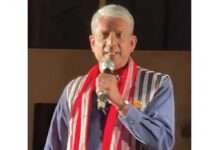[ Suhas Chakma ]
On 15 August, 2021, Chief Minister Pema Khandu in his Independence Day address announced that the Chakmas and Hajongs will be settled outside of Arunachal Pradesh. Thereafter, union Law Minister Kiren Rijiju in various public meetings stated that, following the enactment of the Citizenship Amendment Act of 2019, the Supreme Court judgment of 1996, granting citizenship, has been nullified and therefore all the Chakmas have to leave the state. He stated that there should not be any “galat premi” (illusion) among the Chakmas that they shall have to leave the state.
In my view, such an attitude does not help resolution of any problem. If there has been any discussion on such a move with the Chakmas and Hajongs, both the chief minister and union law minister have killed the initiative.
The Chakmas and Hajongs who escaped religious persecution in the then East Pakistan were settled in the then centrally administered North East Frontier Agency (NEFA) along with ex-Assam Rifles for the defence of India, following the 1962 Sino-India war. They were settled by the appropriate authority at the relevant point of time, and therefore the matter ends there. However, because of discrimination which started in the wake of the anti-foreigner agitation in Assam, not a single Chakma and Hajong out of 14,888 Chakmas and Hajongs who had migrated in 1964 has been granted citizenship despite two Supreme Court judgments on 9 January, 1996 and 17 September, 2015. Further, overwhelming majority of the descendants of these migrants, who are citizens by birth under Section 3 of the Citizenship Act, have not been included in the voter lists because of racial profiling.
This proposal to deport the Chakmas in the name of settlement amounts to racial profiling of the Chakmas and Hajongs. First, Arunachal Pradesh had granted citizenship to the Lisus/Yobins who had migrated to Arunachal Pradesh in the 1960s en masse, vide notification dated 18 January, 1994. This grant of citizenship en masse is absolutely illegal because,
under the Citizenship Act of 1955, each applicant has to submit his/her application individually and there is no provision in the Citizenship Act to declare a category of people as “citizens” en masse. If the Lisus can be granted citizenship in violation of the law of the land, why not the Chakmas and Hajongs, following the law of the land? Is it because they do not have ethnic brethrens in the state? Second, Arunachal Pradesh implements special programmes for the Tibetan refugees in the state but no question is raised. Third, the population of Chakmas and Hajongs, which was 14,888 during 1964-69, only increased to 47,471 as per the 2011 census, ie, 218 percent in 47 years, while the population of other non-tribals increased by 955 percent during the same period, ie, from 36,614 persons in 1961 to 3,84,435 persons in 2011, as per the census, and many of these non-tribals were not settled by the union of India. Therefore, why target the Chakmas and Hajongs only?
Arunachal Pradesh is playing with fire. If Arunachal Pradesh wants to settle the Chakmas and Hajongs in other states, it will be expected that Arunachal Pradesh too must equally share the population burden of other states of India, considering that it is more sparsely populated. In fact, more settlements in sparsely populated Arunachal Pradesh will be argued for ensuring territorial integrity of India, given China’s threat. There are regular incursions from China along the Sino-India borders while the threats from China to the territorial integrity of India are real and more serious than in 1962.
The final question is whether the Citizenship Amendment Act of 2019 nullifies the Supreme Court judgment of 1996, granting the Chakmas and Hajongs of Arunachal Pradesh citizenship.
The CAA, which was enacted in December 2019, does not apply to the Chakmas and Hajongs of the state as they had migrated during 1964-1968. The Chakmas and Hajongs are governed by the Citizenship Act of 1955, under which they had submitted applications 21 years ago in 1998, but these applications have not been processed by the state of Arunachal Pradesh in clear contempt of the Supreme Court order and violation of the Citizenship Rules. The citizenship applications of these Chakma and Hajong immigrants have been under adjudication of the Supreme Court in IA No 4 of 2017 in Writ Petition No 510 of 2007, and it is not proper to pass judgments on a sub judice matter.
The fact remains that over 96 percent of about 60,000 Chakmas and Hajongs of Arunachal Pradesh are citizens of India by birth, born and brought up in Arunachal Pradesh, which is their motherland. As citizens of this country, they have their right to all the rights guaranteed under the constitution of India and both the union of India and the state of Arunachal Pradesh are duty-bound to protect their rights. The constitution of India does not give power to the union of India and the states to forcibly resettle in any place; rather, Article 21 of the constitution of India guarantees the right to freedom of movement.
This attempt to dump the Chakmas and Hajongs in Arunachal Pradesh is not new. After 30 September, 1994 deadline was given to the Chakmas and Hajongs to leave Arunachal Pradesh, the then chief minister of Arunachal Pradesh, Gegong Apang tried to dump them into Assam, and on 21.09.1994, about 2,000 Chakmas from Kokila, Papum Pare district, fled to Assam. On 12 September, 1994, they were forced back, and the then Assam chief minister Hiteshwar Saikia ordered sealing of the border and issued “shoot at sight order” to prevent Assam from being reduced to what late Saikia termed “dumping ground.”
This government must learn its lessons. About 30,000 internally displaced Brus of Mizoram are being settled in Tripura, following the signing of an agreement with the government of Tripura. The Brus had been staying in Tripura for the last 24 years, since October 1997. However, there has been tremendous opposition to the Bru resettlement and incidents of violence and the process of rehabilitation effectively remains suspended.
The union of India or the states must not create more conflicts, nor must it aid to create ethnocentric states. However, without raising temperatures on social media or before the public, there can be still solutions to any contentious issue through dialogue. (The contributor is the founder of the Chakma Development Foundation of India.)


